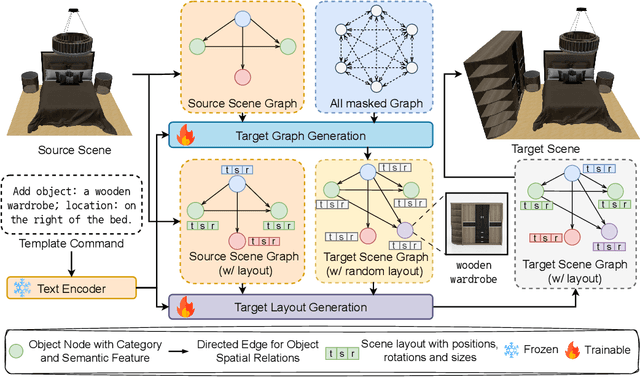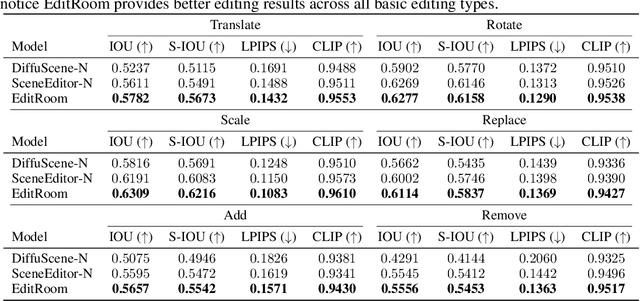Xin Eric Wang
Self-Resource Allocation in Multi-Agent LLM Systems
Apr 02, 2025Abstract:With the development of LLMs as agents, there is a growing interest in connecting multiple agents into multi-agent systems to solve tasks concurrently, focusing on their role in task assignment and coordination. This paper explores how LLMs can effectively allocate computational tasks among multiple agents, considering factors such as cost, efficiency, and performance. In this work, we address key questions, including the effectiveness of LLMs as orchestrators and planners, comparing their effectiveness in task assignment and coordination. Our experiments demonstrate that LLMs can achieve high validity and accuracy in resource allocation tasks. We find that the planner method outperforms the orchestrator method in handling concurrent actions, resulting in improved efficiency and better utilization of agents. Additionally, we show that providing explicit information about worker capabilities enhances the allocation strategies of planners, particularly when dealing with suboptimal workers.
Agent S2: A Compositional Generalist-Specialist Framework for Computer Use Agents
Apr 01, 2025Abstract:Computer use agents automate digital tasks by directly interacting with graphical user interfaces (GUIs) on computers and mobile devices, offering significant potential to enhance human productivity by completing an open-ended space of user queries. However, current agents face significant challenges: imprecise grounding of GUI elements, difficulties with long-horizon task planning, and performance bottlenecks from relying on single generalist models for diverse cognitive tasks. To this end, we introduce Agent S2, a novel compositional framework that delegates cognitive responsibilities across various generalist and specialist models. We propose a novel Mixture-of-Grounding technique to achieve precise GUI localization and introduce Proactive Hierarchical Planning, dynamically refining action plans at multiple temporal scales in response to evolving observations. Evaluations demonstrate that Agent S2 establishes new state-of-the-art (SOTA) performance on three prominent computer use benchmarks. Specifically, Agent S2 achieves 18.9% and 32.7% relative improvements over leading baseline agents such as Claude Computer Use and UI-TARS on the OSWorld 15-step and 50-step evaluation. Moreover, Agent S2 generalizes effectively to other operating systems and applications, surpassing previous best methods by 52.8% on WindowsAgentArena and by 16.52% on AndroidWorld relatively. Code available at https://github.com/simular-ai/Agent-S.
Multimodal Inconsistency Reasoning (MMIR): A New Benchmark for Multimodal Reasoning Models
Feb 22, 2025Abstract:Existing Multimodal Large Language Models (MLLMs) are predominantly trained and tested on consistent visual-textual inputs, leaving open the question of whether they can handle inconsistencies in real-world, layout-rich content. To bridge this gap, we propose the Multimodal Inconsistency Reasoning (MMIR) benchmark to assess MLLMs' ability to detect and reason about semantic mismatches in artifacts such as webpages, presentation slides, and posters. MMIR comprises 534 challenging samples, each containing synthetically injected errors across five reasoning-heavy categories: Factual Contradiction, Identity Misattribution, Contextual Mismatch, Quantitative Discrepancy, and Temporal/Spatial Incoherence. We evaluate six state-of-the-art MLLMs, showing that models with dedicated multimodal reasoning capabilities, such as o1, substantially outperform their counterparts while open-source models remain particularly vulnerable to inconsistency errors. Detailed error analyses further show that models excel in detecting inconsistencies confined to a single modality, particularly in text, but struggle with cross-modal conflicts and complex layouts. Probing experiments reveal that single-modality prompting, including Chain-of-Thought (CoT) and Set-of-Mark (SoM) methods, yields marginal gains, revealing a key bottleneck in cross-modal reasoning. Our findings highlight the need for advanced multimodal reasoning and point to future research on multimodal inconsistency.
The Hidden Risks of Large Reasoning Models: A Safety Assessment of R1
Feb 18, 2025Abstract:The rapid development of large reasoning models, such as OpenAI-o3 and DeepSeek-R1, has led to significant improvements in complex reasoning over non-reasoning large language models~(LLMs). However, their enhanced capabilities, combined with the open-source access of models like DeepSeek-R1, raise serious safety concerns, particularly regarding their potential for misuse. In this work, we present a comprehensive safety assessment of these reasoning models, leveraging established safety benchmarks to evaluate their compliance with safety regulations. Furthermore, we investigate their susceptibility to adversarial attacks, such as jailbreaking and prompt injection, to assess their robustness in real-world applications. Through our multi-faceted analysis, we uncover four key findings: (1) There is a significant safety gap between the open-source R1 models and the o3-mini model, on both safety benchmark and attack, suggesting more safety effort on R1 is needed. (2) The distilled reasoning model shows poorer safety performance compared to its safety-aligned base models. (3) The stronger the model's reasoning ability, the greater the potential harm it may cause when answering unsafe questions. (4) The thinking process in R1 models pose greater safety concerns than their final answers. Our study provides insights into the security implications of reasoning models and highlights the need for further advancements in R1 models' safety to close the gap.
GUI-Bee: Align GUI Action Grounding to Novel Environments via Autonomous Exploration
Jan 27, 2025Abstract:Graphical User Interface (GUI) action grounding is a critical step in GUI automation that maps language instructions to actionable elements on GUI screens. Most recent works of GUI action grounding leverage large GUI datasets to fine-tune MLLMs. However, the fine-tuning data always covers limited GUI environments, and we find the performance of the resulting model deteriorates in novel environments. We argue that the GUI grounding models should be further aligned to the novel environments to reveal their full potential, when the inference is known to involve novel environments, i.e., environments not used during the previous fine-tuning. To realize this, we first propose GUI-Bee, an MLLM-based autonomous agent, to collect high-quality, environment-specific data through exploration and then continuously fine-tune GUI grounding models with the collected data. Our agent leverages a novel Q-value-Incentive In-Context Reinforcement Learning (Q-ICRL) method to optimize exploration efficiency and data quality. Additionally, we introduce NovelScreenSpot, a benchmark for testing how well the data can help align GUI action grounding models to novel environments and demonstrate the effectiveness of data collected by GUI-Bee in the experiments. Furthermore, we conduct an ablation study to validate the Q-ICRL method in enhancing the efficiency of GUI-Bee. Project page: https://gui-bee.github.io
Mojito: Motion Trajectory and Intensity Control for Video Generation
Dec 12, 2024



Abstract:Recent advancements in diffusion models have shown great promise in producing high-quality video content. However, efficiently training diffusion models capable of integrating directional guidance and controllable motion intensity remains a challenging and under-explored area. This paper introduces Mojito, a diffusion model that incorporates both \textbf{Mo}tion tra\textbf{j}ectory and \textbf{i}ntensi\textbf{t}y contr\textbf{o}l for text to video generation. Specifically, Mojito features a Directional Motion Control module that leverages cross-attention to efficiently direct the generated object's motion without additional training, alongside a Motion Intensity Modulator that uses optical flow maps generated from videos to guide varying levels of motion intensity. Extensive experiments demonstrate Mojito's effectiveness in achieving precise trajectory and intensity control with high computational efficiency, generating motion patterns that closely match specified directions and intensities, providing realistic dynamics that align well with natural motion in real-world scenarios.
Agent S: An Open Agentic Framework that Uses Computers Like a Human
Oct 10, 2024



Abstract:We present Agent S, an open agentic framework that enables autonomous interaction with computers through a Graphical User Interface (GUI), aimed at transforming human-computer interaction by automating complex, multi-step tasks. Agent S aims to address three key challenges in automating computer tasks: acquiring domain-specific knowledge, planning over long task horizons, and handling dynamic, non-uniform interfaces. To this end, Agent S introduces experience-augmented hierarchical planning, which learns from external knowledge search and internal experience retrieval at multiple levels, facilitating efficient task planning and subtask execution. In addition, it employs an Agent-Computer Interface (ACI) to better elicit the reasoning and control capabilities of GUI agents based on Multimodal Large Language Models (MLLMs). Evaluation on the OSWorld benchmark shows that Agent S outperforms the baseline by 9.37% on success rate (an 83.6% relative improvement) and achieves a new state-of-the-art. Comprehensive analysis highlights the effectiveness of individual components and provides insights for future improvements. Furthermore, Agent S demonstrates broad generalizability to different operating systems on a newly-released WindowsAgentArena benchmark. Code available at https://github.com/simular-ai/Agent-S.
Multimodal Situational Safety
Oct 08, 2024



Abstract:Multimodal Large Language Models (MLLMs) are rapidly evolving, demonstrating impressive capabilities as multimodal assistants that interact with both humans and their environments. However, this increased sophistication introduces significant safety concerns. In this paper, we present the first evaluation and analysis of a novel safety challenge termed Multimodal Situational Safety, which explores how safety considerations vary based on the specific situation in which the user or agent is engaged. We argue that for an MLLM to respond safely, whether through language or action, it often needs to assess the safety implications of a language query within its corresponding visual context. To evaluate this capability, we develop the Multimodal Situational Safety benchmark (MSSBench) to assess the situational safety performance of current MLLMs. The dataset comprises 1,820 language query-image pairs, half of which the image context is safe, and the other half is unsafe. We also develop an evaluation framework that analyzes key safety aspects, including explicit safety reasoning, visual understanding, and, crucially, situational safety reasoning. Our findings reveal that current MLLMs struggle with this nuanced safety problem in the instruction-following setting and struggle to tackle these situational safety challenges all at once, highlighting a key area for future research. Furthermore, we develop multi-agent pipelines to coordinately solve safety challenges, which shows consistent improvement in safety over the original MLLM response. Code and data: mssbench.github.io.
EditRoom: LLM-parameterized Graph Diffusion for Composable 3D Room Layout Editing
Oct 03, 2024



Abstract:Given the steep learning curve of professional 3D software and the time-consuming process of managing large 3D assets, language-guided 3D scene editing has significant potential in fields such as virtual reality, augmented reality, and gaming. However, recent approaches to language-guided 3D scene editing either require manual interventions or focus only on appearance modifications without supporting comprehensive scene layout changes. In response, we propose Edit-Room, a unified framework capable of executing a variety of layout edits through natural language commands, without requiring manual intervention. Specifically, EditRoom leverages Large Language Models (LLMs) for command planning and generates target scenes using a diffusion-based method, enabling six types of edits: rotate, translate, scale, replace, add, and remove. To address the lack of data for language-guided 3D scene editing, we have developed an automatic pipeline to augment existing 3D scene synthesis datasets and introduced EditRoom-DB, a large-scale dataset with 83k editing pairs, for training and evaluation. Our experiments demonstrate that our approach consistently outperforms other baselines across all metrics, indicating higher accuracy and coherence in language-guided scene layout editing.
NavGPT-2: Unleashing Navigational Reasoning Capability for Large Vision-Language Models
Jul 17, 2024Abstract:Capitalizing on the remarkable advancements in Large Language Models (LLMs), there is a burgeoning initiative to harness LLMs for instruction following robotic navigation. Such a trend underscores the potential of LLMs to generalize navigational reasoning and diverse language understanding. However, a significant discrepancy in agent performance is observed when integrating LLMs in the Vision-and-Language navigation (VLN) tasks compared to previous downstream specialist models. Furthermore, the inherent capacity of language to interpret and facilitate communication in agent interactions is often underutilized in these integrations. In this work, we strive to bridge the divide between VLN-specialized models and LLM-based navigation paradigms, while maintaining the interpretative prowess of LLMs in generating linguistic navigational reasoning. By aligning visual content in a frozen LLM, we encompass visual observation comprehension for LLMs and exploit a way to incorporate LLMs and navigation policy networks for effective action predictions and navigational reasoning. We demonstrate the data efficiency of the proposed methods and eliminate the gap between LM-based agents and state-of-the-art VLN specialists.
 Add to Chrome
Add to Chrome Add to Firefox
Add to Firefox Add to Edge
Add to Edge